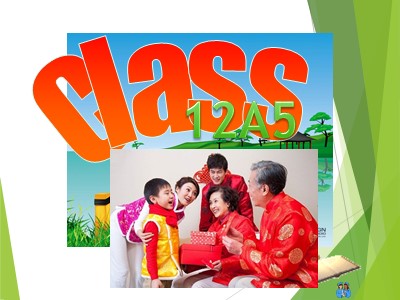Bài giảng môn Tiếng Anh Lớp 12 - Unit 5: Cultural identity - Lesson 1: Getting started

Cultural identity: Bản sắc văn hóa
Traditional costumes: Trang phục truyền thống
Belief: Tín ngưỡng
Cultural practices: Phong tục văn hóa
Maintain: Duy trì
Bạn đang xem 20 trang mẫu của tài liệu "Bài giảng môn Tiếng Anh Lớp 12 - Unit 5: Cultural identity - Lesson 1: Getting started", để tải tài liệu gốc về máy bạn click vào nút DOWNLOAD ở trên
Class 12A5Preserving cultural identityWhat do you know about the Japanese’s culture? ● Language ● National flower ● Traditional costumes, food etc Language: Japanese Traditional costume: KimonoTraditional foods: kamen, sushi Traditional game: Kendama, Takoage National flower: Cherry blossom ❶ Cultural identity Bản sắc văn hóa❷ Traditional costumes Trang phục truyền thống❸ Belief Tín ngưỡng❹ Cultural practices Phong tục văn hóa❺ Maintain Duy trìtraditional costume trang phục truyền thống traditional costume trang phục truyền thống1. cultural identity /ˈkʌltʃərəl aɪˈdentəti/ (n): bản sắc văn hóa 2. for example /ɪɡˈzɑːmpl/: ví dụ như 3. traditional costume /trəˈdɪʃənl ˈkɒstjuːm/ (n): trang phục truyền thống 4. preserve /prɪˈzɜːv/ (v): bảo tồn 5. national identity (n): bản sắc quốc gia 6. belief /bɪˈliːf/ (n): niềm tin 7. religious belief /rɪˈlɪdʒəs/ (n): niềm tin về tôn giáo NEW WORDS8. wonder /ˈwʌndə(r)/ (v): tự hỏi 9. motherland /ˈmʌðəlænd/ (n): quê hương 10. important /ɪmˈpɔːtnt/ (adj): quan trọng 11. essential /ɪˈsenʃl/ (adj): cần thiết 12. family history (n): tiền sử gia đình 13. tradition /trəˈdɪʃn/ (n): truyền thống 14. familiar with something /fəˈmɪliə(r)/ (adj): quen thuộc với gì 15. maintain /meɪnˈteɪn/ (v): duy trì 16. celebrate /ˈselɪbreɪt/ (v): ăn mừng 17. cherry blossom festival: lễ hội hoa anh đào nở2. Complete the diagramlanguagefoodclothingbeliefsCultural practicesTask 3. Answer the questions1. According to Yumi, why do people need to protect their cultural identity?2. How do Yumi’s family maintain their culture?3. Where is home for Yumi?4. Give example of expressions of cultural identity in your community.According to Yumi, why do people need to protect their cultural identity?3. Answer the questionsShe thinks people can do that through the language they speak, the food they eat and certain style of clothing.How do Yumi’s family maintain their culture?They wear kimonos on special occasions and celebrate festival they eat sashini and udon noodles. They speak Japannese at home.Where is home for Yumi?She doesn’t know whether Vietnam or Japan is her home. Her parents come from Japan, but she was born and grew up in Vietnam.Give example of expressions of cultural identity in your community.Languagee VietnameseFoodSquare and round sticky cakePho (Phở)Clothing Ao dai (Áo dài)Ao ba ba (Áo bà ba)BeliefAncestor workshipCultural practicesHung King’s FestivalQuan ho Singing4. Find the verb or adjective that goes with each of the following nouns or noun phrases. If necessary, use a dictionary to check the meaning.ProtectTraditionalCulturalUnderstandMaintain5. Read the conversation again and write the correct tenses of the verbs in brackets. 1. My parent (live)__________________ for twenty years. 2. I (be) ________ to Kyoto four or five times to visit my grandparents.have been living here‘ve been1. Do you think it is essential to preserve our cultural identity?2. How do we preserve it?3. Why do we preserve it? Discussion- Do exercises again at home.- Prepare for the next lesson. Homework
Tài liệu đính kèm:
 bai_giang_mon_tieng_anh_lop_12_unit_5_cultural_identity_less.pptx
bai_giang_mon_tieng_anh_lop_12_unit_5_cultural_identity_less.pptx



